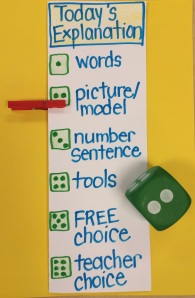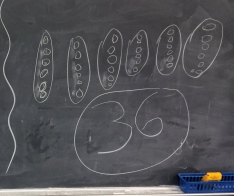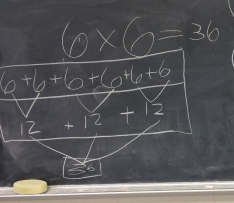A few weeks ago it was time for our daily problem solving block in math class, and I looked over a few shoulders to find the most aggravating thing. The answers written (sometimes incorrectly) with nothing else.
So here was the problem (from Practice Problems for Multiplication and Division):
Jessie bakes cupcakes for her local business. Six orders were called in on the phone. Each order included a half dozen cupcakes. How many cupcakes should she make?
Young learners are notorious for answering math problems like this:
That’s it. Granted it is the correct answer, but no explanation of their thinking or their strategy. SO aggravating for a teacher who is constantly pushing for students to explain their reasoning. SO not in line with the math practice standards and what they are pushing students to do.
So I implemented a little game to help transform problem solving, specifically targeting how they are explaining their thinking. This poster is up hanging on my chalkboard:
Here is how the “game” works:
1. A student rolls the dice.
2. Whatever we land on is the preferred method of communication for the day. The students must try to explain their strategy on their papers using:
- words to describe the steps taken to solve the problem, including how you arrived at the answer.
- a picture or a model of the problem.
- a number sentence to show how the problem was solved.
- tools (manipulatives) to act out the problem. We typically gather around a desk (each student has their own bag of tools) to see how they solved it.
- FREE choice means just that, they can use their favorite way to solve the problem (maybe some other creative strategy beyond any of these four).
- Teacher’s choice. This is kind of awesome because I can ask them to use number lines, graphs, skip counting or some other type of strategy that is appropriate to the problem type.
3. The same student reads the problem out loud to the class (twice).
4. The students solve the problem on their paper as many ways as they can (choosing their best way first), but when they explain it they should try to use the method of communication that was rolled.
5. Two students are asked to come up to the board to show how they solved the problem, and explain their thinking. At least one of the students must have used the method of communication that was rolled.
Since I’ve started to use this, students have gotten better at showing their work, which in turn has made them better at explaining their thinking verbally. It also leads to awesome questions asked of the students who come up to explain their strategy.
Here is what that same problem looked like after we rolled the dice and asked that same student to use the strategy of a model/picture:
Additionally, the other student who came up used a number sentence.
Both great strategies! I love that it encourages the use of different ways to explain, especially when some students get in a rut by only one strategy or one way to explain. It has also been a big help to students who have trouble putting their picture into number sentences.
The best part? The kids think it’s like they are playing the lottery every day.




This is awesome! I am going to start using this strategy immediately!!! Thank you for sharing!
LikeLike
Thank you Anna! I love to share, and love when others share. We all become better that way. Happy New Year!
LikeLike
That is awesome- Iwill incorporate this.
LikeLike
[…] · We love this fun math game that will get students to explain their thinking in one simple step (via Beyond Traditional Math) […]
LikeLike
[…] · We love this fun math game that will get students to explain their thinking in one simple step (via Beyond Traditional Math) […]
LikeLike
What a great idea! My students do the same thing so this game will really help.
LikeLike
[…] math buddy, Beyond Traditional Math uses a similar strategy, so please check it […]
LikeLike
Cannot wait to implement this new-to-me strategy! Thanks for sharing. What a great way to encourage students to think mathematically!
LikeLike
Reblogged this on Become the Best that You Can Be.
LikeLike
I agree that its important to explain one’s reasoning at various points when learning new concepts. However, the point of various modelling paradigms and explanations are that different learners conceptualize the problem differently. Recognizing that we all don’t think exactly the same does it really make sense to force everyone to answer the problem using every different style of explanation? I’m more fond of requiring explanations and then finding alternative ones from different students. Let the kids pick their way to answer and maybe from time to time ask why they picked that line of reasoning. Rather than saying everyone should learn how to explain every problem in all n different ways all the time.
LikeLike
Hi Ben! Thanks for commenting!
I hope you saw this part of the blog post: “The students solve the problem on their paper as many ways as they can (choosing their best way first), but when they explain it they should try to use the method of communication that was rolled.”
You are totally right, the key is they choose their best way first. What I noticed about asking them to try these new ways, is that it takes them out of their comfort zone (at the third grade level they were solving the same way, over and over) and can help them to think more deeply. In addition, they began to finally connect number sentences with their models, which is a key developmental moment in their lives. Also sometimes students need to see a strategy a few times before they even know that their minds could use it!
I totally agree with you, they should definitely be in control of their own strategy, this just pushes them a *little* further…:)
LikeLike
I just stumbled upon this strategy and it seems great but could you explain what tools the students have.
LikeLike